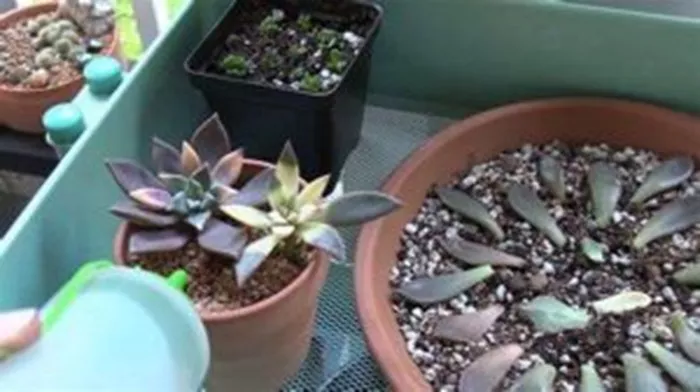Succulent cuttings are a great way to expand your collection or start a new one. However, knowing how often to water them can be a bit tricky. In this article, we will explore the factors that affect watering succulent cuttings and provide some guidelines on how often to water them.
Understanding Succulent Cuttings
Before we discuss watering, it’s important to understand what succulent cuttings are and how they grow. Succulent cuttings are pieces of a succulent plant that have been removed and can be used to grow a new plant. Cuttings can be taken from stems, leaves, or offsets.
When a succulent cutting is taken, it begins to heal at the cut end. This process is called callusing. Once the cutting has callused over, it can begin to develop roots. As the roots grow, the cutting will start to absorb water and nutrients from the soil.
Factors Affecting Watering Succulent Cuttings
Type of Cutting
The type of cutting you have can affect how often it needs to be watered. Stem cuttings generally need to be watered more frequently than leaf cuttings. This is because stem cuttings have more surface area and can lose water more quickly.
Potting Medium
The type of potting medium you use can also affect watering frequency. Succulent cuttings need a well-draining potting mix to prevent root rot. A mix that is too dense or holds too much water can lead to overwatering and cause the cuttings to rot.
Environmental Conditions
The environmental conditions in which your cuttings are growing can also affect watering frequency. Factors such as temperature, humidity, and light exposure can all impact how quickly the soil dries out. In hot, dry conditions, the soil will dry out more quickly and the cuttings will need to be watered more often. In cooler, more humid conditions, the soil will stay moist for longer and the cuttings will need less frequent watering.
Size of Pot
The size of the pot you are using can also affect watering frequency. Smaller pots will dry out more quickly than larger pots, so cuttings in smaller pots will need to be watered more often.
Guidelines for Watering Succulent Cuttings
Wait for Callusing
Before watering your succulent cuttings, it’s important to wait for them to callus over. This can take anywhere from a few days to a week or more, depending on the type of cutting and environmental conditions. Once the cuttings have callused over, they are less likely to rot when watered.
Water Sparingly
When you do water your succulent cuttings, be sure to water sparingly. You don’t want to saturate the soil or leave the cuttings sitting in water. A good rule of thumb is to water just enough to moisten the soil. You can use a spray bottle or a watering can with a fine nozzle to apply water gently.
Check the Soil
Before watering your succulent cuttings, check the soil to see if it is dry. You can do this by sticking your finger into the soil up to the first knuckle. If the soil feels dry at that depth, it’s time to water. If the soil is still moist, wait a few more days before checking again.
Adjust Frequency Based on Conditions
As mentioned earlier, environmental conditions can affect how often you need to water your succulent cuttings. In hot, dry conditions, you may need to water your cuttings every few days. In cooler, more humid conditions, you may be able to go a week or more between waterings. Pay attention to the soil moisture and adjust your watering frequency as needed.
Avoid Overwatering
Overwatering is one of the most common mistakes people make when watering succulent cuttings. Too much water can lead to root rot and kill the cuttings. Be sure to let the soil dry out between waterings and avoid saturating the soil.
Signs of Overwatering and Underwatering
It’s important to be able to recognize the signs of overwatering and underwatering so that you can adjust your watering schedule accordingly. Here are some signs to look for:
1、Overwatering
- Yellowing or mushy leaves
- Mold or fungus growing on the soil or cuttings
- Stunted growth or wilting
- Rotting at the base of the cutting
2、Underwatering
- Wrinkled or shriveled leaves
- Dry soil that pulls away from the sides of the pot
- Slow growth or no new growth
Tips for Watering Succulent Cuttings
Use Room Temperature Water
When watering your cuttings, use room temperature water. Cold water can shock the cuttings and cause stress.
Water in the Morning
Water your cuttings in the morning so that any excess water has time to evaporate during the day. Avoid watering in the evening or at night, as this can lead to moisture buildup and increase the risk of rot.
Provide Adequate Drainage
Make sure your pots have adequate drainage holes to allow excess water to escape. You can also add a layer of gravel or perlite to the bottom of the pot to improve drainage.
Don’t Move Cutings While Wet
Avoid moving your cuttings while they are wet, as this can damage the delicate roots that are starting to form. Wait until the soil is dry before handling the cuttings.
Conclusion
Watering succulent cuttings can be a bit of a balancing act. You want to provide enough water to keep the cuttings hydrated without overwatering and causing rot. By understanding the factors that affect watering frequency and following the guidelines and tips provided in this article, you can help ensure the success of your succulent cuttings. Remember to be patient and observant, and adjust your watering schedule as needed based on the conditions of your cuttings and their environment.


